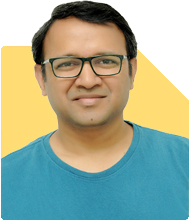Ramalingam Kalirajan |10240 Answers |Ask -Follow
Mutual Funds, Financial Planning Expert - Answered on Jul 10, 2025
He has an MBA in finance from the University of Madras and is a certified financial planner.
He is the director and chief financial planner at Holistic Investment, a Chennai-based firm that offers financial planning and wealth management advice.... more

I have a LAP with my bank. With a limit of 1.00 cr Current utilized amount is 52 lakh. My building is planning to go under redevelopment. I only have LAP as a debt Demat as current value 30- lakh (invested amount is 20 lakh) as a 3+ years long term vission. We are 40 years and 42 years (my wife and I) I have inheritance property worth 75 lakh We want to retire by 55 years Have a medical insurance of 20 lakh (my wife and I) Insurance as 85k p.a.(Axis max) Total Business revenue as 85 lakh p.a. (profit margin upto 10%) Need your guidance.
Your business earns Rs 85 lakh yearly with 10% margin.
Personal income is around Rs 8.5 lakh yearly before taxes.
You have a LAP of Rs 1 crore with Rs 52 lakh used.
Your demat holdings are Rs 30 lakh with 3+ years horizon.
You also have an inheritance property worth Rs 75 lakh.
Medical insurance for Rs 20 lakh is good coverage.
Life insurance of Rs 85,000 yearly (Axis Max) is an added protection.
? Immediate Focus Areas
Retirement is 13 to 15 years away.
Clear LAP debt steadily.
Build financial independence separate from the inherited property.
Plan for a stable cash flow after retirement.
Protect business income till retirement.
? LAP Debt Management
LAP interest rates are higher than home loans.
Prioritise closing LAP faster to avoid interest drain.
Repay in small chunks from business profits.
Don’t keep LAP balance above Rs 20 lakh after 3 years.
Avoid using inheritance property to close LAP now.
? Business Cash Flow Management
Current profit is about Rs 70,000 monthly.
Work on improving profit margins in the next 5 years.
Aim for 15% net profit over time.
Maintain a business emergency fund of Rs 3 lakh to 6 lakh.
Protect business with adequate general insurance and professional liability cover.
? Demat Portfolio Assessment
Demat portfolio grew from Rs 20 lakh to Rs 30 lakh in 3 years.
This is healthy growth.
Keep this portfolio for long-term retirement corpus.
Don’t redeem for LAP repayment unless urgent.
Focus on actively managed funds, not index funds.
Index funds give average market return without professional judgement.
Active funds managed by experts can outperform markets in long run.
? Retirement Corpus Requirement
You plan to retire at 55.
Assuming Rs 1.5 lakh monthly expenses (inflation adjusted),
You need a corpus of around Rs 2.5 crore to Rs 3 crore.
This should generate income for 25+ years post retirement.
? Asset Allocation Recommendation
Equity mutual funds: 60% for growth.
Debt mutual funds and liquid funds: 30% for stability.
Gold, if any, keep less than 5%.
FD and cash: 5% for liquidity.
Rebalance your allocation every year.
Increase debt allocation gradually 3 to 5 years before retirement.
? Insurance Review
Medical cover of Rs 20 lakh is okay for now.
After retirement, increase it to Rs 25 lakh.
Axis Max life insurance of Rs 85,000 yearly is expensive.
Re-evaluate the need for this cover.
If it is an investment-cum-insurance policy, surrender it.
Reinvest surrender value into mutual funds.
Buy a pure term insurance for 15 years covering Rs 1 crore.
? Suggested Monthly Investments
Start SIP of at least Rs 40,000 monthly now.
Increase it by 10% yearly.
Once LAP is reduced, increase SIP to Rs 60,000 monthly.
Don’t invest in annuities. They give poor returns.
Don’t invest in direct funds.
Direct funds don’t offer personalised review or guidance.
Invest in regular funds through an MFD with CFP credential.
? Managing Redevelopment
Redevelopment of your building will improve property value.
Don’t consider new real estate purchases for investment.
Keep the redeveloped house for personal stay.
Don’t tie up capital in new property purchases.
? Emergency Fund and Safety Net
Maintain Rs 5 lakh in liquid funds as emergency fund.
Don’t park this in FD. Liquid funds give better liquidity.
? Passive Income Strategy Post Retirement
Build a corpus that generates Rs 1.5 lakh monthly.
Withdraw using SWP from mutual funds.
Withdraw cautiously to protect principal.
Equity fund gains above Rs 1.25 lakh taxed at 12.5% LTCG.
STCG is taxed at 20%.
Debt funds taxed as per your tax slab.
Plan systematic withdrawals carefully to save tax.
? Protecting Retirement Corpus
Don’t dip into corpus before 55 years.
Reinvest dividends and capital gains till retirement.
Review your portfolio every year.
? Children’s Education and Family Support
Allocate funds separately for child’s education if required.
Don’t mix retirement savings with family obligations.
If parents are dependent, earmark a separate contingency fund.
? Key Risks to Watch
Business income stability over the next 10 years.
LAP interest rates.
Health insurance coverage post retirement.
Unexpected expenses during redevelopment.
? Final Insights
You have built a strong starting point.
But, retirement readiness is still a work in progress.
Pay down LAP within 5 to 7 years.
Build mutual fund corpus of Rs 2.5 crore by age 55.
Don’t stop SIPs. Increase them yearly.
Surrender investment-cum-insurance policies and switch to pure mutual funds.
Avoid annuities, index funds, and direct plans.
Keep insurance and investments separate.
Review your financial plan yearly with a Certified Financial Planner.
With disciplined investing, you can retire peacefully by 55.
Protect your corpus against inflation, market risk, and expenses.
Best Regards,
K. Ramalingam, MBA, CFP,
Chief Financial Planner,
www.holisticinvestment.in
https://www.youtube.com/@HolisticInvestment
You may like to see similar questions and answers below
Ramalingam Kalirajan |10240 Answers |Ask -Follow
Mutual Funds, Financial Planning Expert - Answered on Jul 27, 2024
Ramalingam Kalirajan |10240 Answers |Ask -Follow
Mutual Funds, Financial Planning Expert - Answered on Jan 30, 2025
Ramalingam Kalirajan |10240 Answers |Ask -Follow
Mutual Funds, Financial Planning Expert - Answered on May 07, 2025
Ramalingam Kalirajan |10240 Answers |Ask -Follow
Mutual Funds, Financial Planning Expert - Answered on Jun 20, 2025
Ramalingam Kalirajan |10240 Answers |Ask -Follow
Mutual Funds, Financial Planning Expert - Answered on Aug 09, 2025
Patrick Dsouza |1367 Answers |Ask -Follow
CAT, XAT, CMAT, CET Expert - Answered on Aug 13, 2025
Nayagam P P |10252 Answers |Ask -Follow
Career Counsellor - Answered on Aug 13, 2025
Nayagam P P |10252 Answers |Ask -Follow
Career Counsellor - Answered on Aug 13, 2025
Nayagam P P |10252 Answers |Ask -Follow
Career Counsellor - Answered on Aug 13, 2025
Nayagam P P |10252 Answers |Ask -Follow
Career Counsellor - Answered on Aug 13, 2025
Nayagam P P |10252 Answers |Ask -Follow
Career Counsellor - Answered on Aug 13, 2025
Nayagam P P |10252 Answers |Ask -Follow
Career Counsellor - Answered on Aug 13, 2025
Nayagam P P |10252 Answers |Ask -Follow
Career Counsellor - Answered on Aug 13, 2025
Nayagam P P |10252 Answers |Ask -Follow
Career Counsellor - Answered on Aug 13, 2025
Nayagam P P |10252 Answers |Ask -Follow
Career Counsellor - Answered on Aug 13, 2025




















